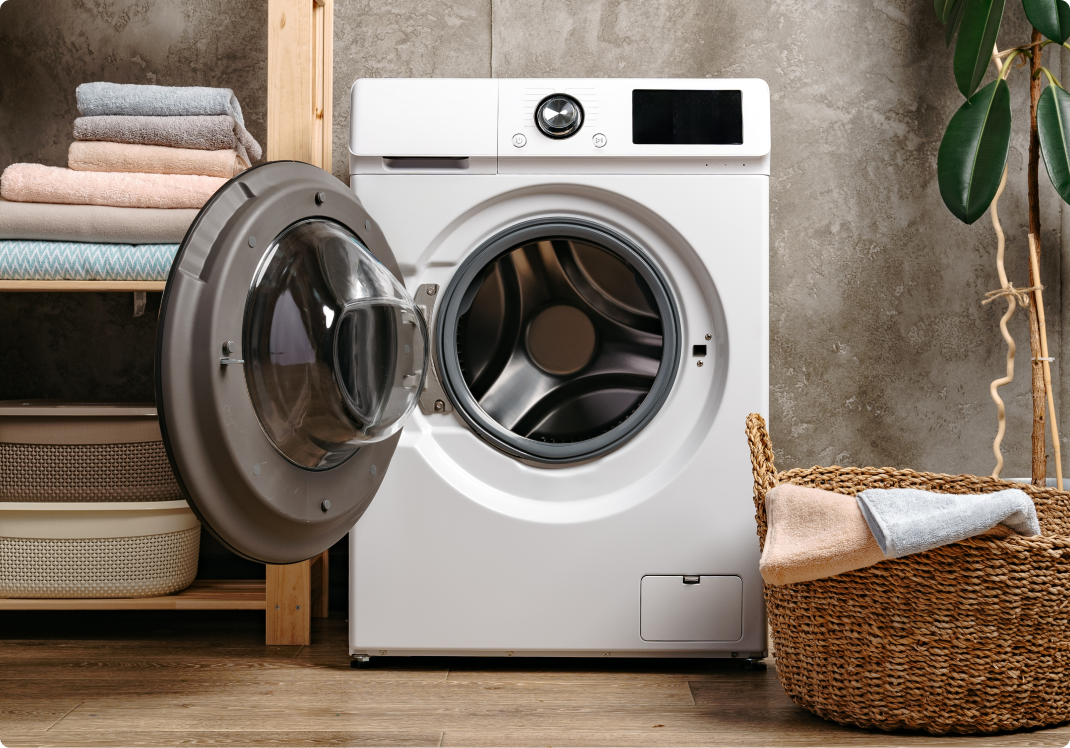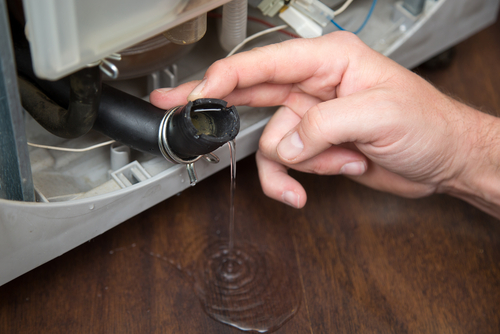
Washer won't drain? Try these 5 troubleshooting tips.

You reach into your washing machine expecting to move your damp clothes over to the dryer. But the clothes are sopping wet, and water’s still standing at the bottom of the tub.
The problem: Your washer isn't draining water properly for some reason. You could put in a quick call to a professional. But before you do, why not try and troubleshoot the problem yourself? You may be able to find and fix the issue and save some money. You can always make that call later. So let’s do a little basic troubleshooting.
What to check when your washing machine won’t drain.
Before checking off the following steps, be sure to turn off electric power to the washing machine by unplugging it from the wall or flipping the electrical panel circuit breaker. You should also remove any standing water from your machine’s tub by bailing it out.
Let’s start with the drain hose.
The culprit behind a washer not draining water could be the hose that carries water from the back of the machine. It could be clogged. Or a kink in the hose could be obstructing the water flow. Or it could be that the unit is jammed too close to the wall, constricting water flow through the hose. To find out if any of those is the reason your washing machine won’t drain:
- Disconnect the drain hose (have a bucket ready to catch any water).
- Shine a flashlight inside to check for any obstruction.
- If you can’t reach what’s clogging the tube, take it outside and flush it with a garden hose.
- Reconnect the drain hose to the machine, turn the electricity back on and run the rinse cycle to see if it’s now draining properly.
You may need to swap out the switch.
The answer to “why isn’t my washer draining?” may be a broken lid switch—typically a small, plastic piece located under the lid or door of the washer. To see if it's working correctly, open the washer and press the switch. If you don’t hear a clicking sound, it may need to be replaced.
Thinking about coverage?
Security for your home. Protection for your budget.
It could be a burned or broken belt.
Check the manufacturer’s diagram of your machine to see where the belts are located. Look for a break or damage and see if one has slipped out of place, or if the drum has malfunctioned and friction has melted or burned the belt since there’s nowhere for it to go. Even if it doesn’t snap in two, there’s enough wear and tear that you’ll need to replace it. Here’s how:
- Unplug the washing machine and disconnect the water supply and hoses, and grab a bucket.
- Remove any clothing clogging drum if that’s the reason the belt has failed.
- Remove the access panel.
- If the belt just slipped off the housing, push it back into place.
- If its damaged, be sure to get the recommended replacement belt.
- Make sure the flat side of the new belt faces out and the grooved side faces in.
- Place part of the belt on the drum pulley, then the other on the motor pulley.
- Turn the drum by hand to tighten the belt in place.
- Replace the panel.
- Re-connect the power and water, and test the washer to make sure you’ve fixed the problem.
Maybe the pump isn’t pumping properly.
Again, check the diagram to find the pump (usually in front or back of the machine). You may need to remove a panel to get to it, so have a screwdriver ready. Then:
- Detach the pump and open it to remove the screen.
- Rinse the screen thoroughly.
- Turn the fan blades or arms to make sure they’re moving freely and that none of them are broken or missing.
- Look in the pump’s outlet part to see if anything is lodged inside.
- Inspect the pump for cracks or leaks.
- If the blades are broken or the pump is leaking, you may need a new one.
The drain might be clogged.
If there’s water in the tub or on the floor, the reason your washer won’t drain could be a clogged drain. Run a plumber’s snake through the drain opening to see if you can clear the stoppage.
TIP: One of the easiest preventive measures you can take to keep your washer draining properly is checking clothes pockets before you wash them. Coins and other small objects can get caught in the pump or other washer components and cause draining issues.
Pay attention to any unusual sounds your washer is making – a forgotten item may be banging around in the tub that could cause drain problems.
Washer not draining water after all that troubleshooting?
If all else fails, read the manufacturer's instructions and recommendations for the type of laundry detergent you should use and how to properly load the machine. If that information doesn’t shed light on why your washer won’t drain properly, you may need to call a professional after all.
While you may be able to replace the washer pump, lid switch or belts yourself, consider having a professional do the job instead. If you can’t clear a clogged drain yourself, don’t hesitate to call a plumber.
Keep in mind that a typical washing machine doing seven loads a week is good for about 14 years. While you can get the most out of your machine’s life expectancy with regular maintenance and some basic washing machine DIY, if yours is pushing its limit and it’s had issues in the past, it may be time for an upgrade. That’s where a washing machine warranty comes in handy.
Protect your washer—and other appliances—with an American Home Shield® home warranty.
Now that you know a little about how to deal with a washing machine not draining, it’s time to think about how to protect it. American Home Shield offers homeowner coverage for all the systems in your home—along with the other home appliances you count on every day, including your washer. And here are a few more tips for addressing a washing machine not draining as well as general home maintenance and repair.
AHS assumes no responsibility, and specifically disclaims all liability, for your use of any and all information contained herein.
Don't worry. Be warranty.
Have a plan for your home when things don't go according to plan
Shop Home Warranties

